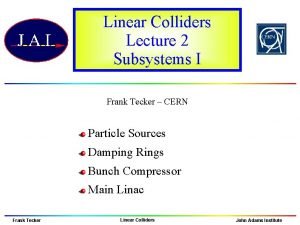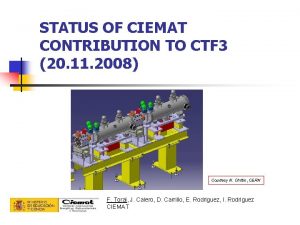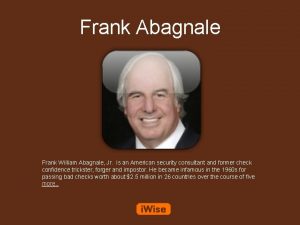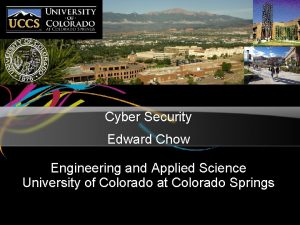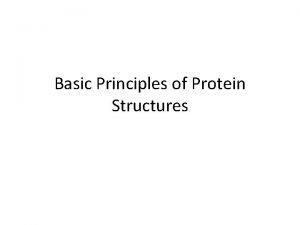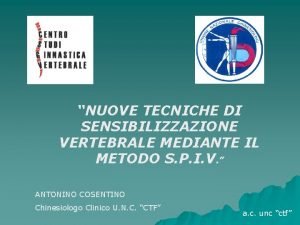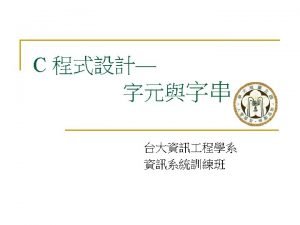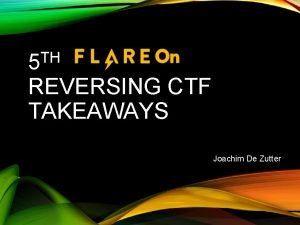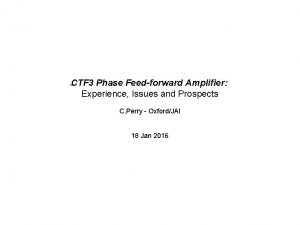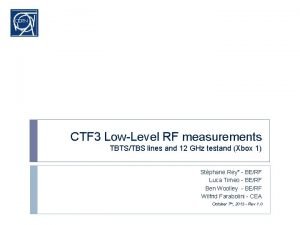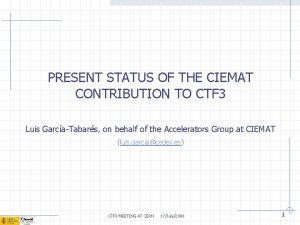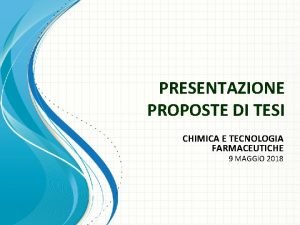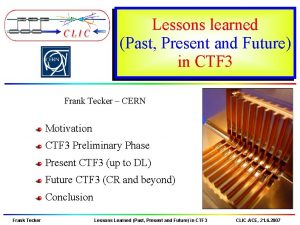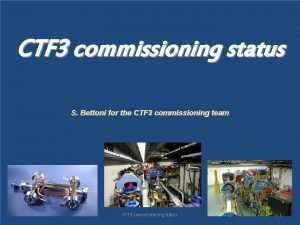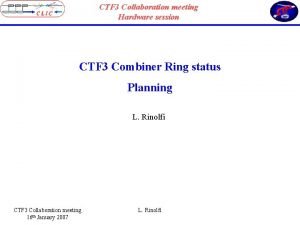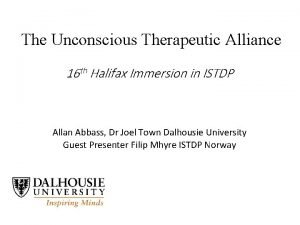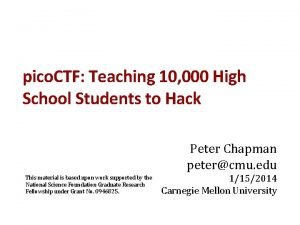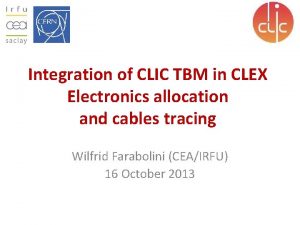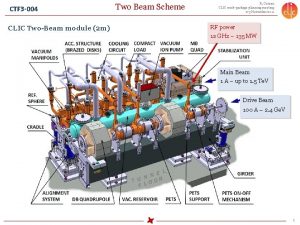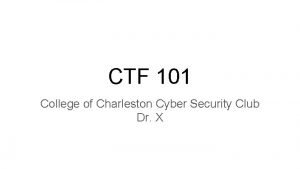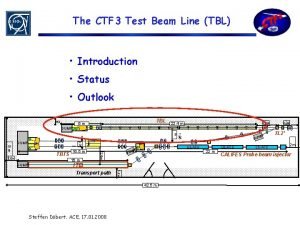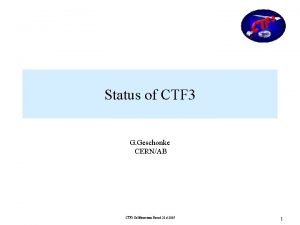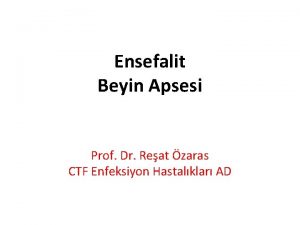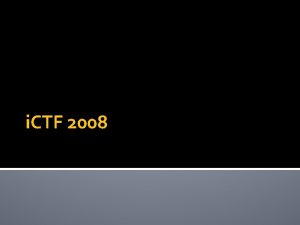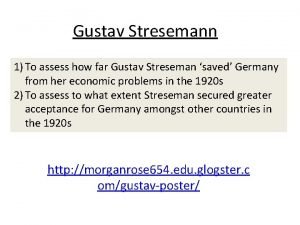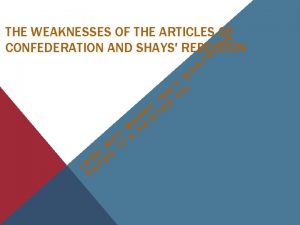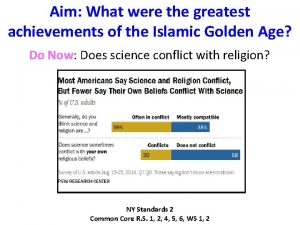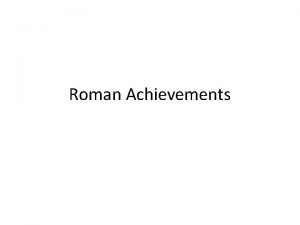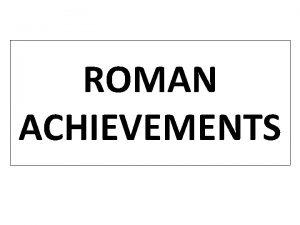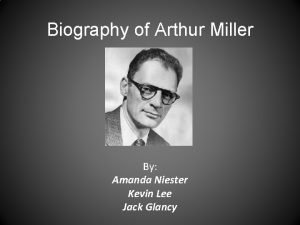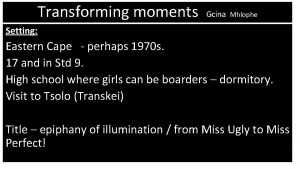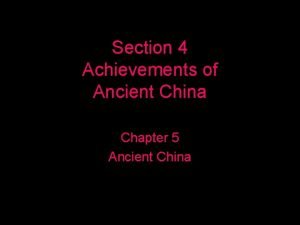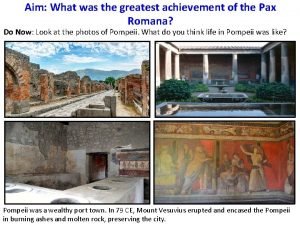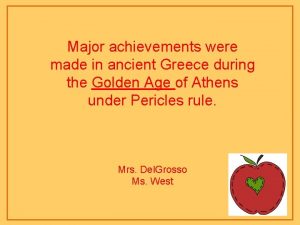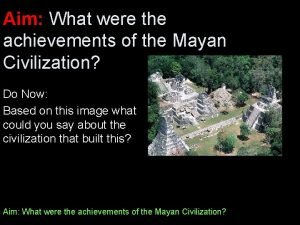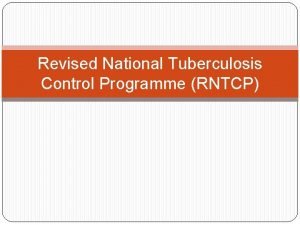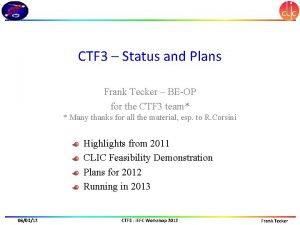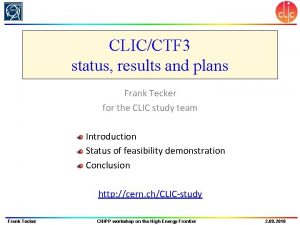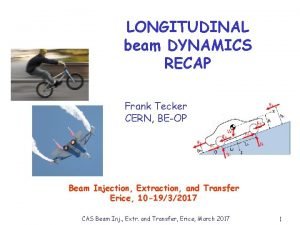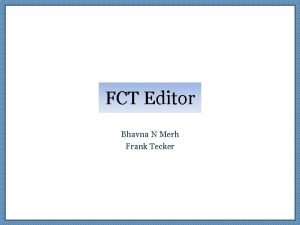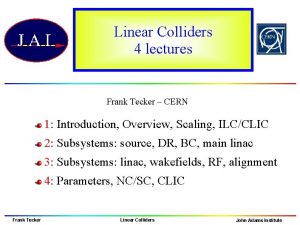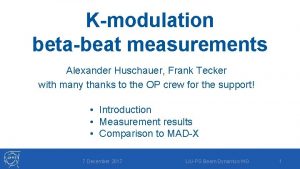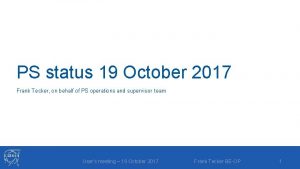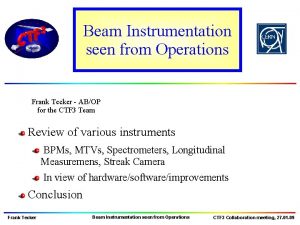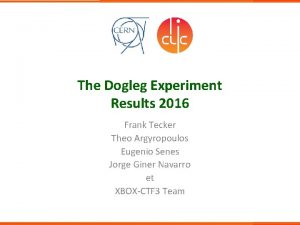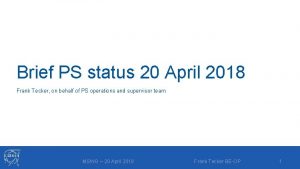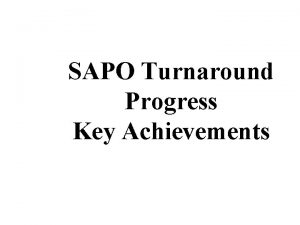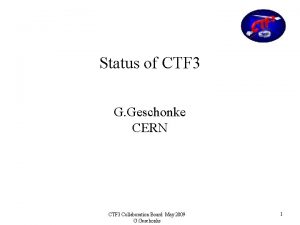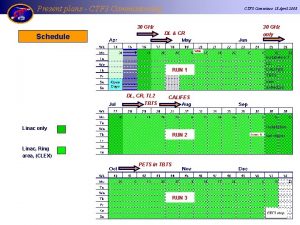CTF 3 progress CTF 3 achievements Frank Tecker


































































- Slides: 66

CTF 3 progress CTF 3 achievements Frank Tecker – CERN for the CTF 3 team Motivation CTF 3 Installation Status CTF 3 achievements Conclusion Frank Tecker CTF 3 progress CLIC-ACE, 3. 9. 2008

CLIC-related key issues as pointed out by ILC-TRC 2003 (beam dynamics in bold) Covered by CTF 3 R 1: Feasibility • R 1. 2: Validation of drive beam generation scheme with fully loaded linac operation • R 1. 1: Test of damped accelerating structure at design gradient and pulse length • R 1. 3: Design and test of damped ON/OFF power extraction structure R 2: Design finalization • R 2. 1: Developments of structures with hard-breaking materials (W, Mo…) • R 2. 2: Validation of stability and losses of DB decelerator; Design of machine protection system • R 2. 3: Test of relevant linac sub-unit with beam • R 2. 4: Validation of drive beam 40 MW, 937 MHz Multi-Beam Klystron with long RF pulse • R 2. 5: Effects of coherent synchrotron radiation in bunch compressors • R 2. 6: Design of an extraction line for 3 Te. V c. m. * Covered by EUROTe. V * Feasibility study done – need development by industry. N. B. : Drive beam acc. structure parameters can be adapted to other klystron power levels Frank Tecker Slide 2 CLIC-ACE, 3. 9. 2008

CLIC Drive Beam generation Delay Loop 2 Drive Beam Accelerator gap creation, pulse compression & frequency multiplication efficient acceleration in fully loaded linac RF Transverse Deflectors Combiner Ring 3 pulse compression & frequency multiplication Combiner Ring 4 pulse compression & frequency multiplication CLIC RF POWER SOURCE LAYOUT Drive Beam Decelerator Section (2 24 in total) Power Extraction Drive beam time structure - final Drive beam time structure - initial 240 ns 140 ms train length - 24 sub-pulses 4. 2 A - 2. 4 Ge. V – 60 cm between bunches Frank Tecker 5. 8 ms 24 pulses – 101 A – 2. 5 cm between bunches Slide 3 CLIC-ACE, 3. 9. 2008

CTF 3 demonstrate Drive Beam generation (fully loaded acceleration, bunch frequency multiplication 8 x) • • Test CLIC accelerating structures • 2003 2004 2005 2006/07 2008/09 Injector + part of linac Linac + 30 GHz test stand Delay Loop TL 1 + Combiner Ring New photo-injector, TL 2 + CLEX Test power production structures (PETS) 30 GHz “PETS Line” Injector Linac Bunch length chicane RF deflector Combiner Ring Delay Loop TL 1 TBL Laser 30 GHz test area TBTS CLEX Frank Tecker TL 2’ CALIFES Slide 4 CLIC-ACE, 3. 9. 2008

CLEX – Installation status 1 DUMP 8 m DFD 2. 0 m F D D F 3. 0 m DF 22. 4 m F D D F 16. 5 m 16 m DUMP F FD DFD F FD LIL-ACS 22 m D P DUM LIL-ACS 3. 0 m DF TL 2’ 2 m CALIFES Probe beam injector F ITB 1. 4 m Transport path D F D MP DU 2. 5 m TBTS D 1. 85 m DFD F 0. 75 DUMP TBL 6 m Beam lines TL 2, TL 2’, CALIFES, and TBTS installed Initial TBL ongoing CALIFES structures RF conditioning soon in October: Probe beam RF gun bake out + RF conditioning TBTS PETS installation New CR RF deflectors Shutdown 08/09: Tail Clipper in TL 2 TBTS accelerating structure Frank Tecker Slide 5 CLIC-ACE, 3. 9. 2008

CTF 3 base line programme CTF 3 – R&D Issues - where recombination x 2 bunch length control fully loaded acceleration phase-coding structures 30 GHz recombination x 4 bunch compression PETS on-off two-beam structures acceleration 12 GHz Deceleration stability R 1. 1 – structures R 1. 2 – DB generation R 1. 3 – PETS on-off R 2. 1 – structure materials R 2. 2 – DB decelerator R 2. 3 – CLIC sub-unit R. Corsini Frank Tecker Slide 6 CLIC-ACE, 3. 9. 2008

Comparison CLIC - CTF 3 CLIC Energy 0. 150 Ge. V 2. 4 Ge. V Pulse length 1. 2 µs 140 µs Multiplication factor 2 x 4 = 8 2 x 3 x 4 = 24 Linac current 3. 75 A 4. 2 A Final current 30 A 100 A RF frequency 3 GHz 1 GHz Deceleration to ~50% energy to 10% energy Repetition rate up to 5 Hz 50 Hz Energy per beam pulse 0. 7 k. J 1400 k. J Average beam power 3. 4 k. W 70 MW Still considerable extrapolation to CLIC parameters Especially total beam power (loss management, machine protection) Good understanding of CTF 3 and benchmarking needed Frank Tecker Slide 7 CLIC-ACE, 3. 9. 2008

Drive beam generation basics Efficient acceleration RF in No RF to load Full beam-loading acceleration in TW sections High beam current Most of RF power to the beam “short” structure - low Ohmic losses Frequency multiplication Beam combination/separation by transverse RF deflectors Frank Tecker Slide 8 CLIC-ACE, 3. 9. 2008

Fully loaded operation Highly efficient acceleration: high beam current high beam loading no power flows into load VACC ≈ 1/2 Vunloaded Disadvantage: any current variation changes energy gain Energy transient Ebeam E 0 Transient 0 DP/P (%) Requires high current stability (suffer from gun variations) 5 at full loading, 1% current variation = 1% voltage variation Steady state steady state -5 E 0 /2 tfill Frank Tecker Slide 9 100 t 200 300 Time (ns) CLIC-ACE, 3. 9. 2008 400

CTF 3 linac acceleration structures Dipole modes suppressed by slotted iris damping (first dipole’s Q factor < 20) and HOM frequency detuning Damping slot Si. C load 3 GHz 2π/3 traveling wave structure 1. 5 ms constant aperture slotted-iris damping + detuning with nose cones up to 4 A 1. 4 µs beam pulse accelerated no sign of beam break-up Frank Tecker Slide 10 CLIC-ACE, 3. 9. 2008

Full beam-loading acceleration in CTF 3 RF pulse at structure input 1. 5 µs beam pulse RF pulse at structure output analog signal Measured RF-to-beam efficiency 95. 3% Theory 96% (~ 4 % ohmic losses) MKS 03 MKS 05 MKS 06 Spectrometer 4 Frank Tecker MKS 07 Spectrometer 10 Slide 11 CLIC-ACE, 3. 9. 2008

Demonstration of frequency multiplication Frank Tecker Slide 12 CLIC-ACE, 3. 9. 2008

RF injection in combiner ring combination factors up to 5 reachable in a ring 1 st turn injection line 2 nd septum 1 st deflector Cring = (n + ¼) l 2 nd deflector local inner orbits RF deflector lo field 4 rd 3 rd lo/4 Frank Tecker Slide 13 CLIC-ACE, 3. 9. 2008

Combination setup Developed a setup procedure to optimize combination 5 parameters Amplitude and phase in each deflector RF frequency (no wiggler for path length tuning) Monitor trajectory differences over various turns Frank Tecker Slide 14 CLIC-ACE, 3. 9. 2008

Combination results intensity profile (Streak Camera) demonstrated for factors 4 and 5 (also 2 and 3) 333 ps 1 pulse beam current accumulates 4 pulses injected Frank Tecker Slide 15 CLIC-ACE, 3. 9. 2008

Combination factor 5 Frank Tecker Slide 16 CLIC-ACE, 3. 9. 2008

Isochronicity Tuning ring optics needs to be isochronous to keep short bunch length => high power extraction efficiency Streak Camera observations non-isochronous – 2 nd turn isochronous – 60 th turn Frank Tecker Slide 17 CLIC-ACE, 3. 9. 2008

Bunch spacing variations would reduce RF extraction efficiency variations were observed (for large orbit oscillations) theoretically understood, vanish when D=D’=0 no deterioration of the power production Frank Tecker Slide 18 CLIC-ACE, 3. 9. 2008

Bunch frequency monitor Analyses different harmonics of 3 GHz target frequency increases other decrease 9 GHz Principle shown in CTF 3 Prel. Phase 12 GHz 15 GHz 18 GHz Frank Tecker Slide 19 CLIC-ACE, 3. 9. 2008

Bunch length manipulations Compression for linac (especially PETS running) Tunable bunch length chicane (see next slides) Isochronous rings, TL 1 (to be done…) Tunable TL 2 (we just got there…) Combiner Ring Delay Loop Compression chicane Injector Linac Bunch length chicane TL 1 Laser TL 2 Frank Tecker Slide 20 CLIC-ACE, 3. 9. 2008

Bunch length manipulation in the INFN chicane Accelerating structures On Girder 15 4 Bends Frascati Chicane Delay Loop RF Deflector Lower energy Nominal energy Higher energy Changing the phase of Klystron 15 to insert a time to energy correlation within the bunch Convert energy correlation into path length modification and time correlation Klystron V(t) RF pick-up Measure Bunch length 2 methods: - frequency spectrum - RF deflector + screen On-crest Acceleration – the bunch length is conserved through the chicane • t Frank Tecker Screen • Positive Off-crest Acceleration – the bunch gets shorter • Negative Off-crest Acceleration – the bunch gets longer Slide 21 CLIC-ACE, 3. 9. 2008

Measurements by RF deflector sy 0 sy RF deflector off Direct measurement RF ON OFF RF deflector on Deflecting mode TM 11 sno. RF = 0. 35 mm s 0 Xing = 2. 9 mm (6. 7 ps) Average Intensity Scan method RF phase variation Observe band intensity rms*c/f = 2. 84 ± 0. 35 mm Phase of RFD (degree) Frank Tecker Slide 22 A. Dabrowski / H. Shaker CLIC-ACE, 3. 9. 2008

Bunch length measurement using “RF Pick-up” Non-intercepting, self-calibration possible Cross-calibration possible Theory Power Spectrum [a. u. ] Measures harmonic content of beam at (30 -39); (45 -69); (78 -90); (157 -171) GHz Compression of chicane measured Freq [GHz] 4 ps 0 ps Maximum of FFT vs phase MKS 15 Phase MKS 15 (degrees) Frank Tecker Slide 23 A. Dabrowski CLIC-ACE, 3. 9. 2008

CTF 3 Delay Loop Frank Tecker Slide 24 CLIC-ACE, 3. 9. 2008

Delay Loop Principle double repetition frequency and current parts of bunch train delayed in loop RF deflector combines the bunches Frank Tecker Slide 25 CLIC-ACE, 3. 9. 2008

Delay Loop operation TL 1 SHB 2005 SHB 2004 DL gun CR SHB buncher CLEX 2 accelerating structures TL 2 1. 5 GHz sub-harm. bunching system 1. 5 GHz RF deflector Frank Tecker Slide 26 CLIC-ACE, 3. 9. 2008

SHB system – Phase coding Key parameters for the SHB system: 1) time for phase switch < 10 ns (15 1. 5 GHz periods) 2) satellite bunch population < 7 % (particles captured in 3 GHz RF buckets) satellite bunch population: phase switch: main bunch satellite bunch Satellite bunch population was estimated to ~8 %. Phase switch is done within eight 1. 5 GHz periods (<6 ns). Frank Tecker Slide 27 CLIC-ACE, 3. 9. 2008

Delay Loop – full recombination beam before the DL beam after the DL 3. 3 A after chicane => < 6 A after combination (satellites) Frank Tecker Slide 28 CLIC-ACE, 3. 9. 2008

Combiner Ring Frank Tecker Slide 29 CLIC-ACE, 3. 9. 2008

CTF 3 Combiner Ring Status First recombination at higher current achieved Beam current before Combiner Ring 1 st turn of 1 st pulse Beam current in Combiner Ring 2 nd turn of 1 st pulse and 1 st turn of 2 nd pulse 3 rd turn of 1 st pulse, 2 nd turn of 2 nd pulse, 1 st turn of 3 rd pulse Frank Tecker Slide 30 All 4 pulses CLIC-ACE, 3. 9. 2008

CTF 3 Combiner Ring status DL bypassed (no holes, missing factor 2) Linac current lower than nominal Losses during recombination (instability…) 2. 6 A 8. 5 A 10. 4 A Frank Tecker Slide 31 R. Corsini CLIC-ACE, 3. 9. 2008

CR instability The beam is lost after a few turns The losses depend strongly on the pulse length 230 ns 130 ns 60 ns Frank Tecker Slide 32 CLIC-ACE, 3. 9. 2008

Vertical Instability current Vpos Hpos The RF deflectors have a vertical mode that deflects the beam Could be minimized by proper phase advance – not yet done Deflectors will be replaced in October Test Facility important! Frank Tecker Slide 33 CLIC-ACE, 3. 9. 2008

Measurement of the ring length BPR: RF Phase Monitor Combination factor 4 with + 5 error Mix of the beam induced signal and internal frequency (3 GHz) FFT of the signal CF 5, - 1/5 l. RF 1 st turn 2 nd turn 3 rd turn 4 th turn About 1. 5 mm Expected ring length for nominal wiggler current Measured Lfrac = - 1/CF l. RF Wiggler behaviour as expected CF 4, - 1/4 l. RF About 1. 5 mm difference only Frank Tecker Slide 34 CLIC-ACE, 3. 9. 2008

Online Optics Model Doubts on linear optics model Verification by dispersion measurements, response studies Found quadrupole inversions, mix-up, BPM scale + model errors Model significantly improved Further validation foreseen Frank Tecker Slide 35 CLIC-ACE, 3. 9. 2008

The final combination… Delay Loop and Combiner Ring combination simultaneously Operation becomes more demanding Stability + reproducibility 7. 5 A current fluctuations over the pulse (RF phase variation over the pulse - not for CLIC) Isochronicity Emittance in combination … 30 A current ! Frank Tecker Slide 36 CLIC-ACE, 3. 9. 2008

Extraction to TL 2 First beam transported down TL 2 transfer line to CLEX Strip-line extraction kicker in CR working Current Beam on MTV in CLEX Horizontal Current Horizontal Vertical Frank Tecker Slide 37 CLIC-ACE, 3. 9. 2008

Latest news This afternoon: First beam at the end of TBTS drive beam side Frank Tecker Slide 38 CLIC-ACE, 3. 9. 2008

CTF 3 R&D issues - status CTF 3 – R&D Issues - where recombination x 2 recombination x 4 ( ) bunch length control fully loaded acceleration phase-coding structures 30 GHz bunch compression PETS on-off two-beam structures acceleration 12 GHz Deceleration stability R 1. 1 – structures R 1. 2 – DB generation R 1. 3 – PETS on-off R 2. 1 – structure materials R 2. 2 – DB decelerator R 2. 3 – CLIC sub-unit R. Corsini Frank Tecker Slide 39 CLIC-ACE, 3. 9. 2008

To be addressed … Full bunch length manipulations in TL 2 after combination RF power production in CLEX Two-beam operation in TBTS (relevant CLIC sub-unit) Deceleration stability Loss management, machine protection system Satellite bunches Photo injector option … Frank Tecker Slide 40 CLIC-ACE, 3. 9. 2008

CTF 3 schedule Large fraction of installation time this year About 100 days scheduled Time shared between 30 GHz and CR commissioning Also TBTS, Califes, TBL will need time Access systems coupled (will disappear) Down time for component failures Frank Tecker Slide 41 CLIC-ACE, 3. 9. 2008

CTF 3 electron gun source of significant down time and problems last year and now two vacuum leaks due to DC dark current various other failures power supply voltage instability (no spare!) makes commissioning very tedious => needs consolidation Missing electronics engineer (white paper post just published) Side remark: also for RF small team of specialists, very efficient but limited Frank Tecker Slide 42 CLIC-ACE, 3. 9. 2008

CTF 3 operation 3 staff (partial) + 1 fellow (ending) operate the machine Recent support by 2 x 50% of OP staff, 1 new fellow 1 white paper post missing Try to maximize run time by 2 ‘shifts’ per day (voluntary) Weekly supervisor to coordinate activity Daily commissioning meeting Remarks: Work concentrated on commissioning of new components Increased complexity Higher demand for availability of components Full recombination (DL + CR) to be demonstrated Operation becomes more demanding in terms of stability Review the performance and identify bottlenecks Frank Tecker Slide 43 CLIC-ACE, 3. 9. 2008

Conclusion fully loaded operation demonstrated and routinely used but we see the consequences from gun variations! bunch train combination principle shown (Prel. Phase) optimization procedures developed phase coding of bunches and full current DL operation full current CR combination on a good way but still to be done => fully loaded drive beam generation well covered but still a big step to final demonstration performance and stability still to be addressed Many more detailed studies needed => see Roberto’s talk Many THANKS to all collaborators! Frank Tecker Slide 44 CLIC-ACE, 3. 9. 2008

Additional slides Frank Tecker Slide 45 CLIC-ACE, 3. 9. 2008

CTF 3 installation status Beam lines TL 2, TL 2’, CALIFES, and TBTS installed Initial TBL ongoing CALIFES structures RF conditioning soon in October: Probe beam RF gun bake out + RF conditioning TBTS PETS installation New CR RF deflectors Shutdown 08/09: Tail Clipper in TL 2 TBTS accelerating structure Frank Tecker Slide 46 CLIC-ACE, 3. 9. 2008

CLIC drive beam scheme Very high gradients possible with NC accelerating structures at high RF frequencies (30 GHz → 12 GHz) Extract required high RF power from an intense e- “drive beam” Generate efficiently long beam pulse and compress it (in power + frequency) 800 Klystrons Low frequency High efficiency Long RF Pulses P 0 , n 0 , t 0 Frank Tecker Power stored in electron beam Power extracted from beam 144000 in resonant structures Accelerating Structures High Frequency – High field Electron beam manipulation Power compression Frequency multiplication Slide 47 Short RF Pulses PA = P 0 N 1 t. A = t 0 / N 2 n. A = n 0 N 3 CLIC-ACE, 3. 9. 2008

Delay Loop – first recombination 2005 0. 2 Satellites straight Satellites delayed beam current (A) 0 -0. 2 Beam in DL -0. 4 -0. 6 Beam in DL (delayed) Main bunches delayed Main bunches straight -0. 8 -1 -1. 2 5150 Beam before DL 5250 Beam after DL Phase switch 5350 5450 5550 5650 5750 5850 time (ns) Frank Tecker Slide 48 CLIC-ACE, 3. 9. 2008

CLEX – Two beam test stand High-power test of PETS – first tests of CLIC (lengthened) prototypes 12 GHz high-power test of accelerating structures Two beam acceleration of ‘main’ beam from CALIFES Measurement of breakdown kick, breakdown current meas. planned High-power test of PETS on/off mechanism Operation of CLIC module Frank Tecker Slide 49 CLIC-ACE, 3. 9. 2008

CLEX – Test beam line 1 DUMP 8 m DFD 2. 0 m 16. 5 m 16 m DUMP F F D D F DFD F D F F FD LIL-ACS F DU D LIL-ACS 22 m F D D D F P DUM 3. 0 m DF TL 2’ LIL-ACS 2 m CALIFES Probe beam injector F ITB 1. 4 m Transport path D D F D MP 3. 0 m DF 22. 4 m F D FD DFD 2. 5 m TBTS D 1. 85 m DFD F 0. 75 DUMP TBL 6 m 42. 5 m High energy spread beam transport, low losses (Bench mark simulations) RF Power Production, Stability (End Energy <50%, 2. 6 GW of RF power) Alignment (Test procedures for BBA) (100 microns alignment for PETS) Drive Beam Stability, Wake field (no direct measurement of the wake fields) ‘Realistic’ show case of a CLIC decelerator Industrialization of complicated RF components Frank Tecker Slide 50 CLIC-ACE, 3. 9. 2008

CLIC Decelerator vs TBL CLIC TBL E = 2. 37 Ge. V E = 0. 15 Ge. V I ~ 80 A I = 30 A P/pets ~ 170 MW P/pets = 150 MW Wext = 90 % Wext = 55 % (16 cells) Very similar PETS for both machines, 32 A needed to produce nominal Power/PETS Wext = 80 % (23 cells) might be possible with some beam improvements Frank Tecker Slide 51 CLIC-ACE, 3. 9. 2008

TBL 2007/2008 Prototype Module RF-Load Quad BPM Quads BPM PETS Mover Dipole MTV WCM Steering BPM Quads, TL 2 BPR MTV 2 m To Test stand Total: ~6 m Frank Tecker Slide 52 CLIC-ACE, 3. 9. 2008

30 GHz test line Mid-linac power station Test stand CLEX Two-beam Test Area High-power transfer line Main Beam Injector HIGH POWER RF SOURCES m a e B High-gradient test stand, CTF 2 CTF 3 linac PETS branch Frank Tecker Slide 53 CLIC-ACE, 3. 9. 2008

Power extraction structure PETS must extract efficiently >100 MW power from high current drive beam Fast (15 ms) linear movers ON periodically corrugated structure with low impedance (big a/λ) OFF ON/OFF mechanism PETS ON/OFF mechanism Reconstructed from GDFIDL data PETS output pulse envelopes ON Power, norm. Beam eye view OFF Time, ns Frank Tecker Slide 54 CLIC-ACE, 3. 9. 2008 Detuning wedges

30 GHz power production (PETS) 17 m waveguide with 5 bends but low-loss (85% transmission) (Russian collaboration) vacuum tanks containing Power Extraction Transfer Structure First production of 30 GHz RF pulse for nominal CLIC gradient and pulse length in 2005 high power load / accel. structure Frank Tecker Slide 55 CLIC-ACE, 3. 9. 2008

CTF 3 schedule 2006 almost continuous operation all year Split between RF production and commissioning 1 st period: DL commissioning / 30 GHz nights and weekends 2 nd period: only 30 GHz / TL 1+CR installation 3 rd period (very short!): TL 1+CR commissioning / 30 GHz nights + weekends Frank Tecker Slide 56 CLIC-ACE, 3. 9. 2008

30 GHz power testing needs large amount of accumulated running time RF conditioning largely automated CCC (CERN Control Center) operators supervise CTF 3 during night and week-ends SHUTDOWN Circular Cu Six prototype accelerating structures tested in 2006 Installation + testing time per structure have been reduced Switch over from and to commissioning became routine and very fast HDS 60 Cu small HDS 11 Mo HDS 11 Ti HDS 11 Al SHUTDOWN A. Rodriguez Frank Tecker Slide 57 CLIC-ACE, 3. 9. 2008

Conclusion We have shown: Preliminary phase: principle of bunch train combination at low charge for factors 2 -5 isochronicity tuning for ring optics combination set-up procedure developed bunch distance variations understood CTF 3 Linac stable fully loaded operation successfully demonstrated power generation in the mid-linac PETS structure used for extensive structure testing Delay Loop successful phase coding operation with SHB nominal factor 2 combination for 1. 4 us beam pulse (now only 1. 1 us needed) Frank Tecker Slide 58 CLIC-ACE, 3. 9. 2008

Conclusion (cont. ) Combiner Ring: full charge operation and combination CLEX area – TBTS PETS ON/OFF power generation Acceleration of ‘main’ beam Study of breakdown kicks CLEX area – TBL Power extraction Drive beam stability benchmarking Beam Instrumentation Frank Tecker Slide 59 CLIC-ACE, 3. 9. 2008

30 GHz Automatic Conditioning essential for long-term testing! handles break-downs, vacuum, interlocks, … programmable for conditioning and breakdown rate measurements became operational in mid 2006 Frank Tecker Slide 60 CLIC-ACE, 3. 9. 2008

CCC operator supervision previously night and week-end operation by volunteers and collaborators => limited man-power solution: have CCC (CERN Control Center) operators supervise CTF 3 during night and week-ends reset most frequent errors: klystron trips operational environment, tools and documentation prepared first CCC operation: 25. 8. 2006 very smooth from the start! significantly increased up-time Frank Tecker Slide 61 CLIC-ACE, 3. 9. 2008

EURODrive Handling of the high current drive beam simulations and experiments on alignment and tuning: Develop beam based alignment and tuning methods adapted to the drive beam decelerator Develop a conceptual machine protection system Develop a method to correct the drive beam phase jitter (synergy with X-FEL’s) 1. Study the drive beam phase jitter 2. Develop the pickups (BW 100 MHz, 20 fs resolution) and correctors 3. Develop a longitudinal feedback to reduce drive beam phase jitter Benchmarking of simulation codes with CTF 3 experiments including TBL, CR & TBTS (Test-Beam Line, Combiner Ring and Two. Beam Test-Stand) Frank Tecker Slide 62 CLIC-ACE, 3. 9. 2008

Bunch compression bunch length from damping ring: ~ few mm required at IP: ~ few 100 mm or shorter solution: introduce energy/time correlation with chicane: long. phase space N. Walker Frank Tecker Slide 63 CLIC-ACE, 3. 9. 2008

Full beam loading operation in CTF 3 – Demonstration for CLIC operation Idea: Delay always one klystron pulse after the beam pulse and measure relative energy in spectrometer 10 and compare with calculations. An exact knowledge of the structure input power, the beam current and the energy gain is essential. compare to theoretical energy gain (input power, beam current) MKS 05 MKS 06 MKS 07 in in in out in in total energy lower energy o “missing” acceleration (energy gain per structure) o deceleration due to direct beam loading from calculations (beam current) measured RF-to-beam efficiency: 95. 3 % Theory: 96% (~4 % ohmic losses) Frank Tecker Slide 64 CLIC-ACE, 3. 9. 2008

CTF 3 beam loss monitoring Frank Tecker Slide 65 CLIC-ACE, 3. 9. 2008

Structure start from ILC-TRC CTF 3 issues short review CTF 3 motivation and layout CTF 3 Preliminary Phase: RF combination factor 4 and 5 (2, 3) at low current setting up combination tuning isochronicity CTF 3 linac: stable fully loaded operation, efficiency Bunch length manipulation Delay Loop: first combination stage of (old) nom. pulse length (now 5 -> 4) SHB phase coding Combiner Ring nom. combination at full current not yet possible (RF deflectors) TL 2 Conclusion Frank Tecker Slide 66 CLIC-ACE, 3. 9. 2008
 Frank tecker
Frank tecker Intranet.tecker
Intranet.tecker Physical progress and financial progress
Physical progress and financial progress Frank william abagnale jr wife
Frank william abagnale jr wife Ctf
Ctf Ctf
Ctf Ctf
Ctf Ctf
Ctf Osu ctf hackerone
Osu ctf hackerone Strncmp ctf
Strncmp ctf Confuser ex
Confuser ex Ctf
Ctf Twt+
Twt+ Ctf indlæser
Ctf indlæser Ctf
Ctf Bsi unimore
Bsi unimore Pasten ctf
Pasten ctf Ctf ctq
Ctf ctq Ctf
Ctf Hardware ctf
Hardware ctf Terrapin ctf
Terrapin ctf Halifax ctf
Halifax ctf Pico school background
Pico school background Tirocinio ctf unimore
Tirocinio ctf unimore Ctf jeopardy
Ctf jeopardy Ctf
Ctf Clicwork
Clicwork Ctf crypto
Ctf crypto Quadmover
Quadmover Ctf
Ctf Ctf
Ctf Ctf
Ctf Ctf
Ctf Ctf illinois jobs
Ctf illinois jobs Explain the dawes plan
Explain the dawes plan Achievements of the articles of confederation
Achievements of the articles of confederation Jay gould achievements
Jay gould achievements What are the key achievements from the islamic golden age
What are the key achievements from the islamic golden age Kleopatra hrobka
Kleopatra hrobka Roman achievements in art
Roman achievements in art Roman achievements that are still used today
Roman achievements that are still used today Audrey hepburn achievements
Audrey hepburn achievements Ancient romans achievements
Ancient romans achievements Medieval vs renaissance
Medieval vs renaissance Roman achievements
Roman achievements Confederation
Confederation Christopher columbus achievements
Christopher columbus achievements Sumerian records dmca
Sumerian records dmca 618 song
618 song How did miller's social conscience affect his work?
How did miller's social conscience affect his work? Ruby.jlt bridges
Ruby.jlt bridges Ancient china achievements
Ancient china achievements Transforming moments short story by gcina mhlophe
Transforming moments short story by gcina mhlophe Thutmose iii achievements
Thutmose iii achievements Han wudi achievements
Han wudi achievements Hernando de soto accomplishments
Hernando de soto accomplishments Francisco pizarro voyages map
Francisco pizarro voyages map Han dynasty achievements
Han dynasty achievements Pax romana achievements
Pax romana achievements Yuan dynasty achievements
Yuan dynasty achievements Greek achievements in art
Greek achievements in art Pericles accomplishments
Pericles accomplishments Prince henry the navigator accomplishments
Prince henry the navigator accomplishments Japan achievements
Japan achievements What are some achievements of the mayans
What are some achievements of the mayans Rntcp covers the whole country since
Rntcp covers the whole country since Ifrs accounting
Ifrs accounting
